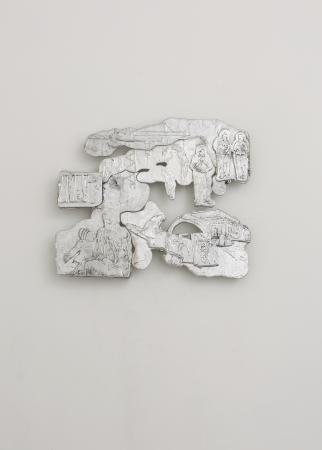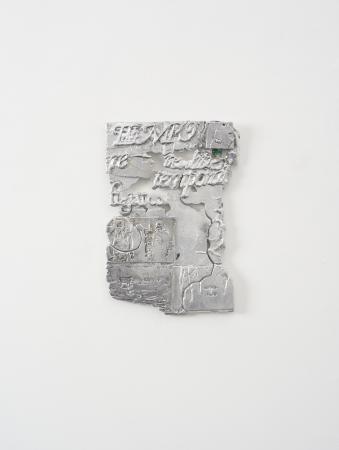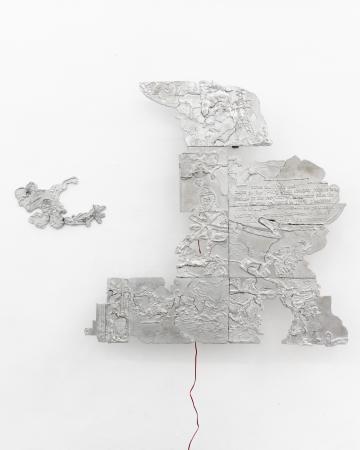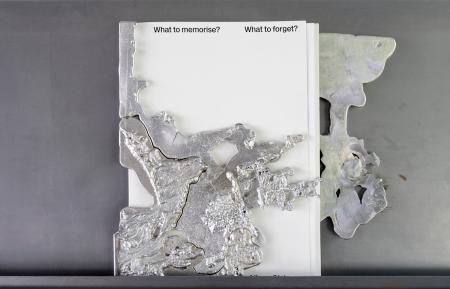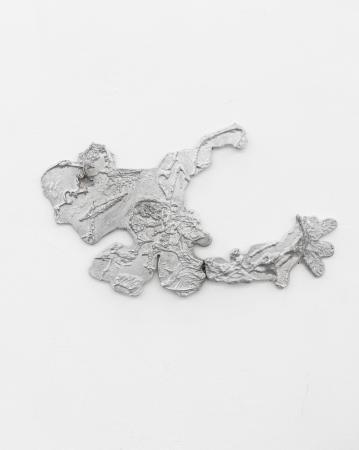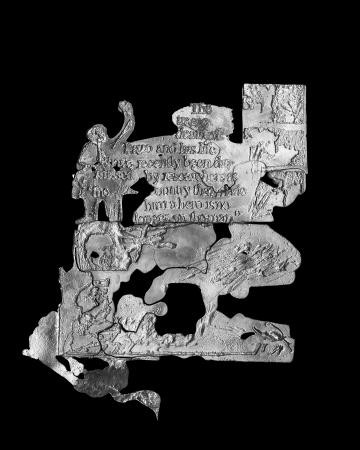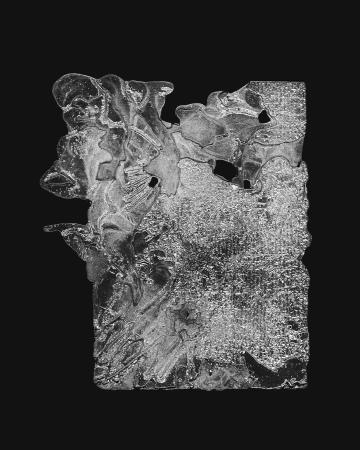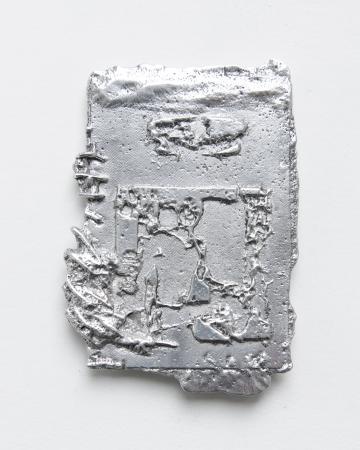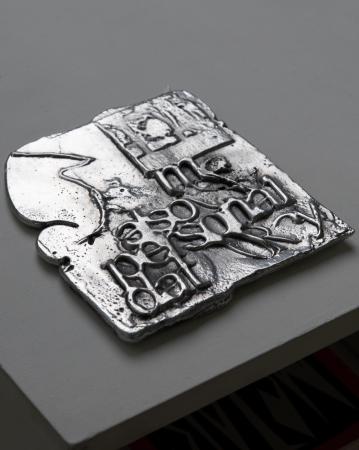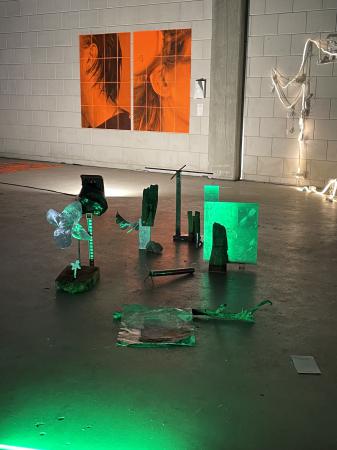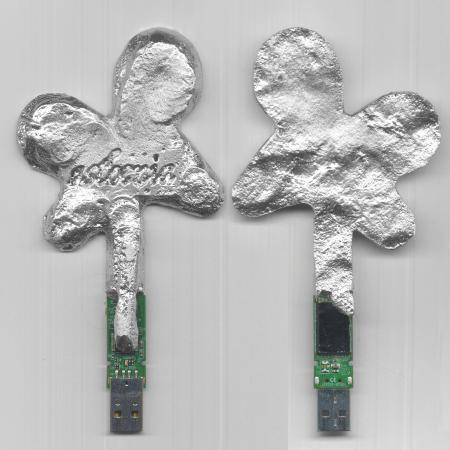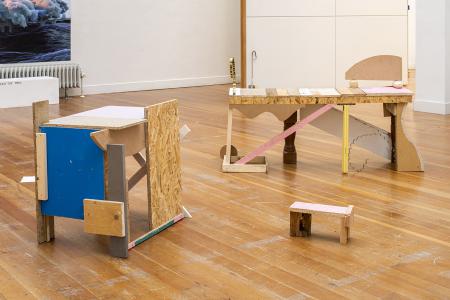-
info
Detached from the main work, ‘What to memorise? What to forget?’. The piece is melted into a story about the city, citing a mosaic from the central station in Chișinău titled “The city is flourishing and being built”. The aluminium encases the changes of the place, unveiling the sequences observed by local researchers.
-
info
-
info
“What to memorise? What to forget?” is a project that explores the collective memory embodied in monuments and collective sites aiming to present an alternative perspective of shared sites of remembrance that were part of ideological dogma. Through an iterative process of impressing images onto aluminium, through melting and remoulding stories the works allows further perspectives, stepping out of political narratives to tell the story of time. The aluminium pottery, widely-used in everyday objects, when used as a part of public and private contexts in Moldova, melts stories of the material into monuments. The stories are shaped by the fluidity of metal: they intertwine and form ongoing narratives.
-
info
Process book
-
info
Becoming is a part of the What to memorise? What to forget? project. A piece cut and melted from main What to memorise? What to forget?, melted into a story about designing a new society, that will serve the political agenda. Adding new material like cutlery and plates to the main work, the piece capture the scene of kids having lunch at the kindergarten in an ongoing developing city.
-
info
Collapse is part of the What to memorise? What to forget? project. Fluid aluminum is molding the story of a fictional hero who received intense support during the Soviet era but was rapidly abandoned after the Union's collapse. The "hero" remains an element of public space, abandoned and falling apart. A monument to a reshaped and colonized memory.
-
info
Melted, a landscape of a collective labour. Shaped into petrified potato flower, a story of long, hot and dry summer, of picking vegetables as part of social life in the name of one togetherness. Now, most of those places are almost abandoned, continuously melting back into the land, by nature, leaving that ruined after taste.
-
info
Man eating soup is part of the What to memorise? What to forget? project, melted into the main piece, was a story of a every day. Melted from pots, aluminium objects, cheap and mass produced during Soviet times, now serve as historical artifacts. Cooking a soup becoming a metaphor of the complex process of colonization. Cooking soup becomes a metaphor for the complex process of colonialism. Could the objects used as personal commodities be untangled from the overall narrative?
-
info
Privacy is a part of the What to memorise? What to forget? project. The works investigate the privacy of memory. An intangible at first glance thing, breaks in front of propaganda, becomes vulnerable and infiltrated. Could thoughts even be private?
-
info
The work delves into desire for personal fulfillment and happiness while acknowledging the toll of constant emotional interaction and the difficulty in building meaningful connections. The metal garden is a metaphor for
-
info
The flower Astenia describes an episode in which the body lacks or has lost strength, either as a whole or in any of its components. In the context of the work Metal garden, the usb flower makes the link between cold and sharp, artificially build image from outside, and vulnerability and insecurity of the inside.
-
info
Since the Republic of Moldova became independent, the country faces a difficult socio-economic situation. As a consequence, the vast majority of the population was forced to migrate temporarily or permanently abroad, to seek employment or education. The Internet became a prominent space to facilitate the reunion of families. The transition influenced the way culture is practiced and shared in Moldova. In this context Aliona investigates the production of her home country's culture, specifically oral tradition. A culture owned and shaped by the community, reflecting its current social life. The production of Moldova’s culture used to take place near people's houses or locations they activate, in spots organized and built according to their needs. Following the transition, Aliona’s installation seeks to revive the place where tradition was formerly practiced and offer an adapted version of it in the current context. She mimics the method of production, as a research form, questioning its authenticity.
Social media
Curriculum vitae
Education
-
2020 - 2024Graphic Design Den Haag, Koninklijke Academie van Beeldende Kunsten diploma
exhibitions
-
2025Metal Memory Limbo Contemporary Milan, Italy Metal Memory, a double solo exhibition by Aliona Ciobanu and Sophia Gatzkan, focuses on the physicality of non-standard bodies and their intellectual secretions, exploring how they both interact with technology to embody narratives of trauma, adaptation and healing. Both artists explore matter as a vehicle for identity and transformation, using it as a starting point to interrogate the socio-cultural and political structures that shape our perceptions of the world. A common theme in their practices is the use of reconfigurative processes, from fusion to assemblage, which allow them to deconstruct and rewrite histories outside of dominant perspectives. Here, memory and metal – understood both as a transformative element and as a vector – meet and become a transformative force. An energy capable of renewing the relational paradigm between contrasting elements and their ability to adapt, creating fluid and nuanced connections. limbo-contemporary.com/exhibition/metal-memory/ Duo
-
2025‘Y/our memory’ Kunsthal Kloof Utrecht, Netherlands Together with guest curator Cees Martens, Kunsthal Kloof presents the work of Elma Čavčić, Alyona Ciobanu, Kelvin Dijk, Dakota Magdalena Mokhammad and Bodil Ouédraogo. The exhibition explores the importance of shared histories and family archives in shaping and discovering one's own identity. In the works presented by the artists, elements of these personal and collective archives play a key role. From newspaper clippings and cooking recipes to religious folklore and family collections. The exhibition also encourages visitors to reflect on their own personal and shared identity and history. Archives are not merely containers of the past. They are, just like us, always part of an ongoing process of becoming. kunsthalkloof.nl Group
-
2024Flower Metals DMW Gallery Antwerp, Belgium Flowers and metals both occur in nature. One alive, of a sacred status and nurtured until cut. The other inanimate, but mangled, melted and deformed into shapes and technologies. Both are gifted to our loved ones. ‘Flower Metals’ puts together a list of artists and their works, which combined create an artificial oase full of objects that are floral and or robust, sacred and or deformed, flower and or metal. ‘Flower Metals’ is a group exhibition featuring works by Anna-Marie Berdychovà, Alyona Ciobanu, Bram De Jonghe, Bella Hunt & DDC, Emilija Povilanskaité, Benny Van den Meulengracht-Vrancx and Walter Wathieu. www.dmwgallery.be/?utm_campaign=linkinbio&utm_medium=referral&utm_source=later-linkinbio Group
-
2022Those among us Dutch Design Week Eindhoven, Netherlands ‘Recipes of displacement’ is a video installation, featured on three screens. The main screen is dedicated to the interviews of five people from different backgrounds, who fled Ukraine. They share stories about their journey to the Netherlands, perceptions of the new status of ‘temporarily relocated persons’, and the overlaps of the Ukrainian-Dutch cultures. The second screen features the process of cooking borshch. www.kabk.nl/nieuws/kabk-students-at-dutch-design-week-2022 Group
-
2021Drawing Appreciation Day at ...ISM project space ...ism The Hague Artist initiative Hgtomi Rosa is a guest at …ism project space for an exhibition in which drawing is central. The project stems from the interest in drawing as a practice and the appreciation for people who use drawing in their lives. Hgtomi Rosa has invited 30 artists to show one drawing. The drawings may differ in size, function, age and success. They can be sketches, explanations, maps with routes on them, instructions, childhood drawings, spontaneous or substantial visual thoughts, drawings that were made to share with other people or a perfectly finished work of art. The artists respond to each other’s drawings through comments, written thoughts and interpretations. In this way the drawings are connected with each other as an expression of thought in image and word. And displayed within the physical space that …ism offers as a space for new thoughts. Your attendance is being valued as a contribution to Drawing Appreciation Day. ismprojects.wordpress.com/2021/09/15/drawing-appreciation-day/ Group
Projects
-
2024
What to memorise? What to forget? The Hague, Netherlands graduation.kabk.nl/2024/aliona-ciobanu “What to memorise? What to forget?” is a project that explores the collective memory embodied in monuments and collective sites aiming to present an alternative perspective of shared sites of remembrance that were part of ideological dogma. Through an iterative process of impressing images onto aluminium, through melting and remoulding stories the works allows further perspectives, stepping out of political narratives to tell the story of time. The aluminium pottery, widely-used in everyday objects, when used as a part of public and private contexts in Moldova, melts stories of the material into monuments. The stories are shaped by the fluidity of metal: they intertwine and form ongoing narratives.
Commissions
-
2024Ex Oriente Ignis Pochen Bienniale Chemnitz, Germany The second part of the 4th POCHEN Biennale comprises an international media art exhibition to open in September 2024. The exhibition featuring some 20 artists is being developed by the Ukrainian curator Serge Klymko, whose current position as managing director of the Kyiv Biennale has helped him gain extensive expertise in the eastern European art scenes. His primary interest lies in the power structures that persist in post-socialistic countries, especially with regard to their impact on art production. The POCHEN Biennale wants to give Ukrainian artists the opportunity to present their works to an international audience. www.pb2024.eu/en finished
-
2023Kyiv Biennal Kyiv Biennial Vienna, Austria Kyiv Biennial is an international forum for art, knowledge, and politics that integrates exhibitions and discussion platforms. It adopts an interdisciplinary perspective at the intersection of the humanities, socially engaged art, and political activism in order to reflect on the crucial issues of the contemporary world. Kyiv Biennial is organized by the Visual Culture Research Center. The fifth edition of the Kyiv Biennial will take place across Europe at locations in Kyiv, Ivano-Frankivsk, Uzhhorod, Berlin, Warsaw, Lublin, Antwerp and Vienna as the main exhibition venue. In view of the brutal Russian attack on Ukraine, a comprehensive biennial project in Kyiv long seemed deeply uncertain, if not impossible. But, with a cascade of openings—starting in Kyiv in October 2023, finishing in Berlin in 2024—the fifth Kyiv Biennial will be taking place. This Biennial edition is conceived as a European event, with dispersed exhibitions and public programs in a number of Ukrainian and EU cities, and realized in partnership with leading European institutions in the field of contemporary art. The project aims to reintegrate the Ukrainian artistic community, divided by war and scattered across Europe, and to enable its actors to work together with international colleagues and partners on the cultural, social and environmental challenges Ukraine is currently facing and to place them in a global context. Artistic images, investigative documentations and institutional practices will be explored with regard to possible exit strategies from the current impasse of war, authoritarianism and colonialism, where the scenarios for a new Ukraine beyond war could even be imagined. 2023.kyivbiennial.org/eng/ finished
